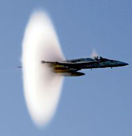
« PREVIOUS ENTRY
With this incredibly gross ring, I thee wed
NEXT ENTRY »
My invisible friends

Apparently if you look very closely at this video of Discovery lifting off (click on “WB-57 Chase Plane Video”), about 50 seconds in you’ll see a white puff of cloud form around the shuttle. I watched the video myself and can’t quite spot it, but I’ve been assured it’s there — it’s just that the video is really shaky. Anyway, the cloud is caused by the deeply cool Prandtl-Glauert Singularity — a sudden, supercold pocket of air generated by a wing that is moving at near the speed of sound.
The clouds appear for the same reason that clouds always form, namely, that the air has cooled to the point that the ambient water vapor condenses. Flows around bodies and wings always change the temperature and pressure of the fluid … At speeds near that of sound, the temperature and pressure variations occurring at every speed can also be exaggerated in steady level flight. The mechanism for this near-sonic exaggeration of the temperature variations is the so-called Prandtl-Glauert singularity which requires that pressure and temperature perturbations approach ±¥ as the flight speed approaches the ambient sound speed.
Someone once told me that just before the Concorde broke the sound barrier, if passengers looked out the window they could “see” sound waves forming along the wings. That’s got a lovely poetry to it, but it’s not true: What Concorde passengers were seeing were Prandtl-Glauert condensation clouds.
(Thanks to Boing Boing for this one!)
I'm Clive Thompson, the author of Smarter Than You Think: How Technology is Changing Our Minds for the Better (Penguin Press). You can order the book now at Amazon, Barnes and Noble, Powells, Indiebound, or through your local bookstore! I'm also a contributing writer for the New York Times Magazine and a columnist for Wired magazine. Email is here or ping me via the antiquated form of AOL IM (pomeranian99).

ECHO
Erik Weissengruber
Vespaboy
Terri Senft
Tom Igoe
El Rey Del Art
Morgan Noel
Maura Johnston
Cori Eckert
Heather Gold
Andrew Hearst
Chris Allbritton
Bret Dawson
Michele Tepper
Sharyn November
Gail Jaitin
Barnaby Marshall
Frankly, I'd Rather Not
The Shifted Librarian
Ryan Bigge
Nick Denton
Howard Sherman's Nuggets
Serial Deviant
Ellen McDermott
Jeff Liu
Marc Kelsey
Chris Shieh
Iron Monkey
Diversions
Rob Toole
Donut Rock City
Ross Judson
Idle Words
J-Walk Blog
The Antic Muse
Tribblescape
Little Things
Jeff Heer
Abstract Dynamics
Snark Market
Plastic Bag
Sensory Impact
Incoming Signals
MemeFirst
MemoryCard
Majikthise
Ludonauts
Boing Boing
Slashdot
Atrios
Smart Mobs
Plastic
Ludology.org
The Feature
Gizmodo
game girl
Mindjack
Techdirt Wireless News
Corante Gaming blog
Corante Social Software blog
ECHO
SciTech Daily
Arts and Letters Daily
Textually.org
BlogPulse
Robots.net
Alan Reiter's Wireless Data Weblog
Brad DeLong
Viral Marketing Blog
Gameblogs
Slashdot Games